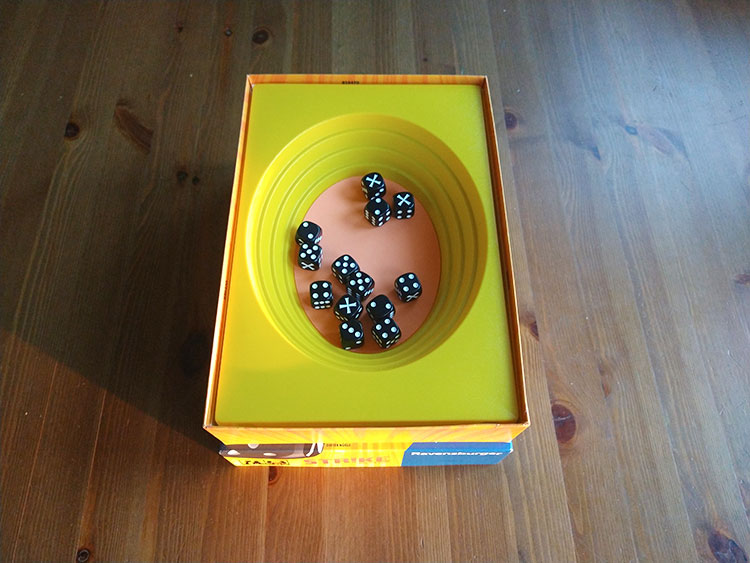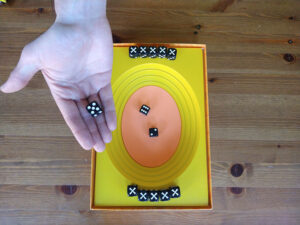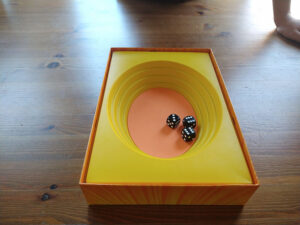 Dice games have come a long way in the last couple of decades. Previously ruled by Yahtzee, Farkle, Shut the Box, and Left, Right, Center, these games have since moved away from dead simplicity in favor of deeper gameplay and modern aesthetics. In 2012, Strike entered the market with the feel of a classic dice game, but with a quirky box. Is it a gimmick? Let’s dive into the arena and find out.
Dice games have come a long way in the last couple of decades. Previously ruled by Yahtzee, Farkle, Shut the Box, and Left, Right, Center, these games have since moved away from dead simplicity in favor of deeper gameplay and modern aesthetics. In 2012, Strike entered the market with the feel of a classic dice game, but with a quirky box. Is it a gimmick? Let’s dive into the arena and find out.
Strike is a dice game for two to five players that lasts about 15 minutes per game. In this new 2020 edition, the color palette has been updated, but the gameplay is unchanged.
Gameplay Overview:
Strike is a last-person-standing, multiplayer, free-for-all dice game. Players start the game with a set number of dice based on the player count. Additionally, one die is rolled into the center of the arena (the inside of the box). Each turn, a player rolls one die, trying to match the number of any die already in the arena. If there’s a match, the player removes all matching dice from the arena and places them in their personal pool of dice. Then, play passes to the next player.
However, if no dice match, all dice remain in the arena. The active player can choose to pass or roll another one of their dice. Players can roll their dice one-by-one until they are out of dice or they choose to pass. Once a player is out of dice, they are eliminated from the game.
The values on each die range from 2-5 with the 6th side displaying an “X.” If any “X” comes up in the arena, that die is removed from the game permanently. Any die being rolled into the arena can legally knock any other die in the arena, causing its value to change. This can result in a situation where all dice in the arena have the same value. In this case, all dice are taken by the active player, leaving the arena clear. When this occurs, the next player must roll all of their dice at once, resolving the roll just like all other rolls.

Game Experience:
As I mentioned in the intro, Strike feels like a classic dice game due to its weight and accessibility. However, it distinguishes itself by possessing the qualities of a raucous party game and a light dexterity game.
With the brevity of the ruleset, you can have Strike up and running with new players in just a couple of minutes. You can even teach as you go with no issue. Additionally, anyone who watches a round or two will be ready to jump in and play right away. Strike is also language-independent, and the rulebook being in six languages adds an extra layer of approachability. It means a lot to me, knowing I can gift this to just about anyone without having to take any extra steps to ensure that they can learn and play on their own.

Strike is addictive. It’s a game that often threatens to take over a whole game night once it’s brought out. If you win, you’ll want to flex your “skills” for another game. If you lose, you’ll want redemption. Since the skill ceiling is relatively low, no player will feel like they are out of contention for winning the next game.
This game can be played with kids, adults, and mixed groups alike. It is language independent and easy to learn. I have played with people as young as 6 and people over 70. I’ve successfully brought it out at family parties, strategy game nights, and conventions. It really does not have a limitation to its audience except fun haters.
Some of the best moments in Strike can be watching someone fail miserably, while not being able to stop themselves from rolling again and again. Someone can lose 2, 5, or more dice in no time. Their angst can cause them to miss the box entirely, which means that the die is out of the game. You need to be able to laugh at your own crappy luck. It’s funny until it happens to someone else… then it’s hilarious!

In all seriousness, if you are looking for a game with strategy any deeper than Craps, you’re not going to find it in Strike. Most turns do not have much of a decision beyond where/how you’ll roll the die. After your first roll, you may have to decide if you’ll keep rolling. In most situations, rolling another die is not the best move. However, the temptation to “hit it big” is always there and often wins out. Such a light ruleset may also limit just how often you want to bring it out. It should be good for a few nights of entertainment a year, which is more than you can say about most games.
Finally, we must discuss the elephant in the room. The theme… especially with this latest iteration, Strike is unapologetically themeless. While it still has the colosseum-style play area, you’d be hard-pressed to explain how the dice are warriors unless you have an incredible imagination. That’s not really a concern here in my opinion. When they’ve tried other themes for this game (e.g. Impact), it only seemed to detract from the simplicity of the experience.
If I had to list one major complaint for my taste, I think this game is pretty ugly. The yellow and orange color scheme is a bit of an eyesore. It’s easy to get past once you start playing, but it’s not going to look great on a display shelf either.
Final Thoughts:
Strike is a great game to bring the rush of the craps table anywhere you go while keeping your bank account safe. That being said, if there was a list of games to gamble on, this would be right up near the top. It has just enough luck along with the big risk, big reward style of decision-making that seems suitable for “high stakes.” Besides that, Strike is a family game, a filler game, a party game, a dexterity game, or whatever you need it to be. I’d call this a new classic.
Final Score: 4.5 Stars – A super accessible and boisterous dice game with stand up moments and drama throughout.
 Hits:
Hits:
• Dead simple ruleset that’s accessible to all
• Addictive push-your-luck dice system
• All the excitement of a craps table without the high stakes
Misses:
• The best strategy is often to pass after your first roll
• Not much luck mitigation
• Color scheme is displeasing
• Would be nice to add a player or two to the player count





















